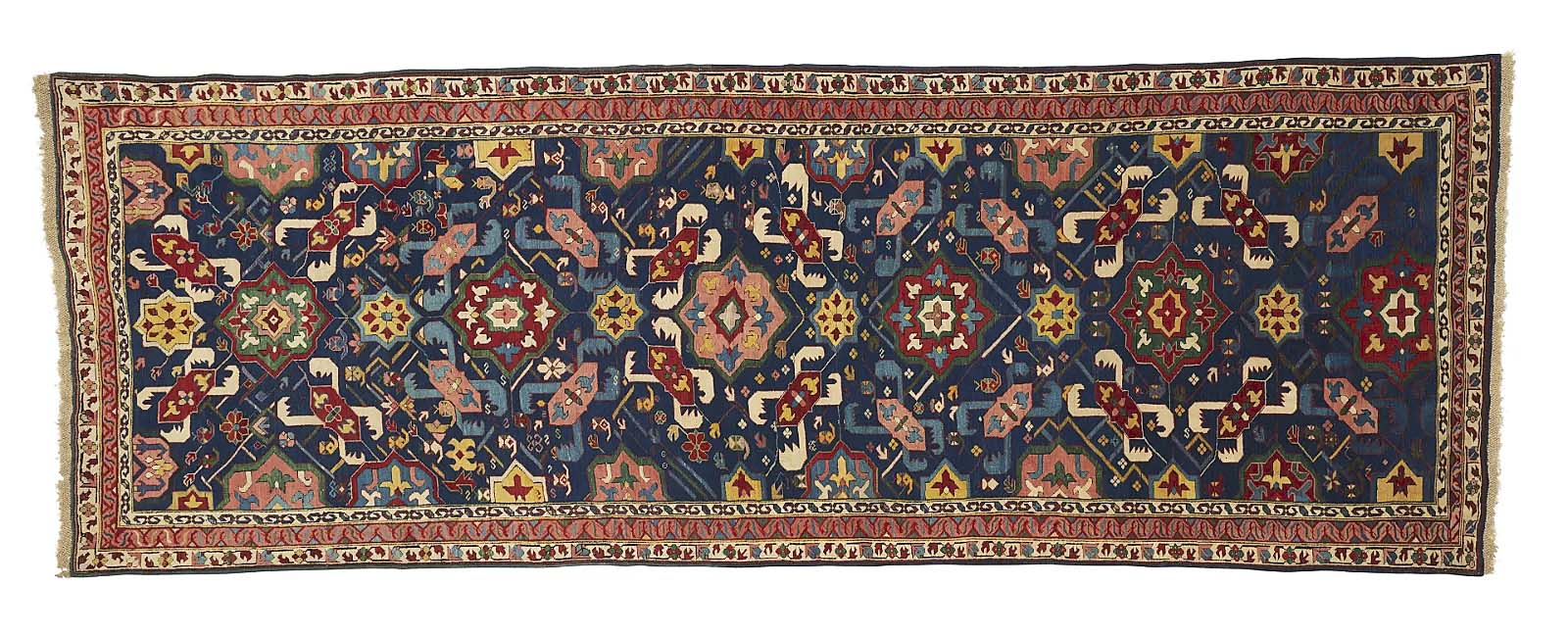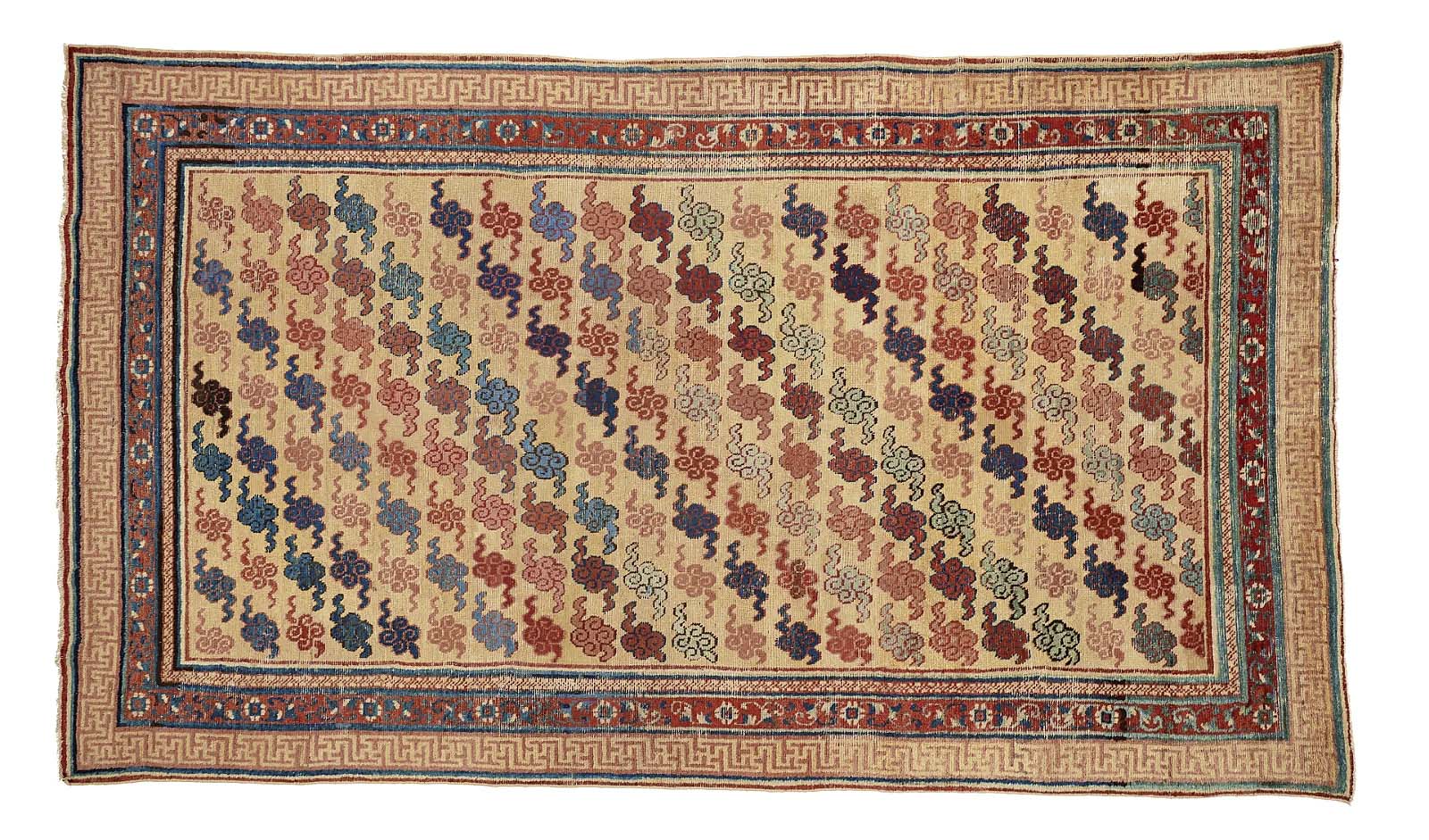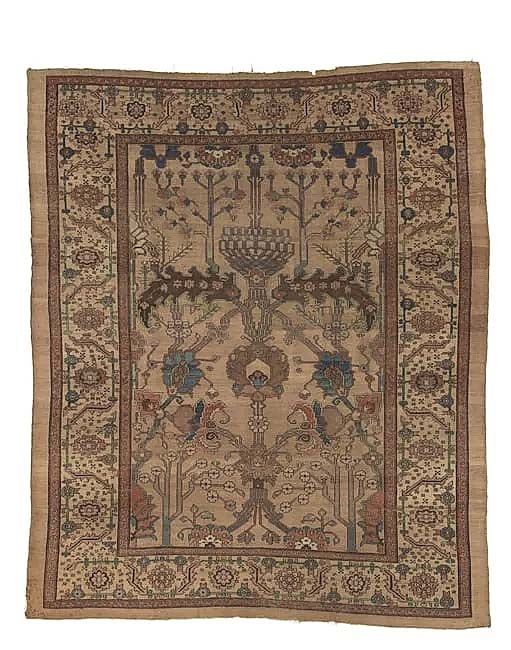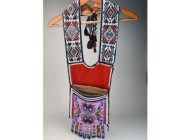
Leading the sale was this Alpan Kuba rug from the Caucasus region, dated circa 1875. It measured 11 by 4 feet and realized $28,125, more than two times its high estimate ($8/12,000).
Review by Kiersten Busch
BOSTON — On June 12, Grogan & Company conducted its Fine Rugs & Textiles auction, offering 260 lots of rugs, carpets and textiles from various regions and notable collections. The sale realized $674,000.
Grogan & Company founder and rug expert Michael B. Grogan remarked, “The results of the rug auction highlighted the fact that the strength of the rug market is for rare and collectible items. Seven of the top 10 lots exceeded their estimates and were purchased by discriminating international collectors and dealers. Combined with the Kaffel Collection Rug auction held in January, Grogan & Company has sold more than $2.6 million in collectible rugs this year.”
“This sale attracted high-quality bidders from around the world,” commented Lilia Hutchins, marketing coordinator for Grogan & Company. There were registered bidders from 72 countries, and more than 8,000 bidders registered overall.
A circa 1875 Alpan Kuba rug led the sale, crossing the block for almost two and a half times its high estimate. It hailed from the Caucasus Mountains, located between Persia and Russia, in modern-day Azerbaijan. The Kuba region was the largest rug center in Azerbaijan, and produced more than 12 subtypes of carpets, including Alpan, each named after the tribe which created them. Alpan carpets, like this example, were known for their medallion designs, most often surrounded by gul and crawfish motifs. The most recognizable colors used in Alpan carpets were dark green and yellows. This particular example, measuring 11 by 4 feet, came from the estate of a Martha’s Vineyard rug collector. “It was his favorite rug,” explained Hutchins. “The condition was immaculate, the color palette saturated and appealing.” It sold to a San Francisco rug collector for $28,125.

The second-highest selling lot was this East Turkestan carpet measuring 10 feet 6 inches by 6 feet 1 inch. It was dated circa 1800 and went to a Greenwich, Conn., collector for $25,000 ($20/30,000).
Earning $25,000 was a carpet from East Turkestan, dated to circa 1800. The 10-foot-6-inch-by-6-foot-1-inch carpet once belonged to a Long Island, N.Y., collector before being consigned by Grogan. These carpets were made in the Xinjiang region in the northwest of China, combining the styles of Chinese and Middle Eastern weavers. Many East Turkestan carpets tended to make use of smaller design elements as space-fillers, more similar to western Oriental rugs, rather than using the more spatial design approach that Chinese rugs were known for. Xinjiang’s position as a stop on the Silk Road allowed for this combination of cultures to influence weavers.
Categorized as “rare” in the auction catalog was a Bidjar Garus carpet from Persia, hailing from the first half of the Nineteenth Century. The carpet came from an upstate New York rug collector, “and was the centerpiece in his living room for over 20 years,” explained Hutchins. Bidjar, a small city in northwest Iran, was established as a center of carpet production some time in the Sixteenth Century, and played an essential role in the industry, mostly due to the quality of the wool from the region. Known as the “iron carpets of Persia,” Bidjar Garus carpets are praised for their long life and durability due to the unique way they were crafted. Weavers would add an extra row of weft between each row of Turkish knots, and would wet the weft before inserting it, so that it would shrink and tighten when it dried. They would also beat the rows down heavily with a comb to create a dense and heavy carpet. Garus referred to the split-arabesque design that particular Bidjar carpets had, which combined florals and geometrics. Typical colors used in a Bidjar Garus carpet were midnight or cobalt blue, like this example. “The unique design led to spirited bidding,” said Hutchins. It ultimately went to a Seattle collector for $25,000.

Earning $23,125 was a Persian Bakshaish carpet, circa 1850, which measured 10 feet 5 inches by 8 feet 7 inches. It sold to a New York City dealer ($5/10,000).
“This rare Persian carpet almost doubled its high estimate,” explained Hutchins about a Bakshaish carpet, which was discovered in a historic Rhode Island house and earned $23,125. The example she waas referring to hailed from a town on the banks of the Talke Rud River in northwest Persia, dated to circa 1850 and measured 10 feet 5 inches by 8 feet 7 inches. Bakshaish was the oldest rug weaving village in the region of Persian Azerbaijan and was known predominantly for its highly artistic carpets that contained a diverse array of abstracted adaptations of age-old tribal and classical Persian motifs, including folkloric characters. Weavers often used soft reds and navy tones for the base color, but many were also ivory-colored or made from golden camelhair. Most commonly, Bakshaish carpets were home crafted, woven in room size or oversize on looms attached to the weaver’s home.
Grogan & Company’s Fall Fine Art and Fine Jewelry sales will take place on November 2 and 3. They are accepting consignments through August. The firm’s next rug auction will take place in January and consignments are already being accepted.
Prices quoted include the buyer’s premium as reported by the auction house. For information, www.groganco.com or 617-720-2020.












